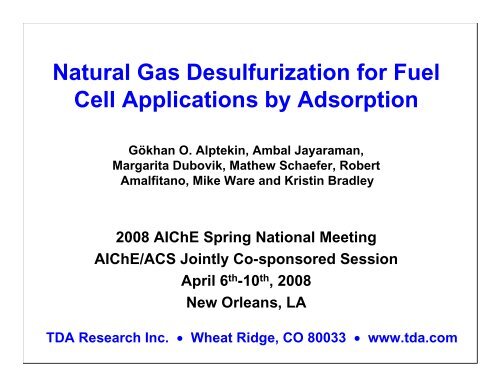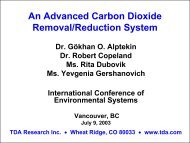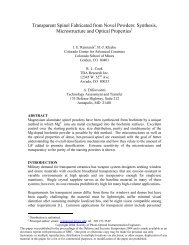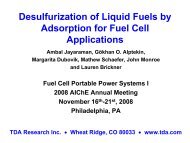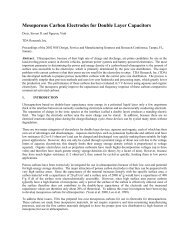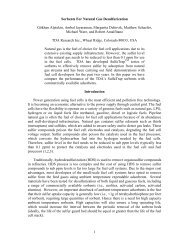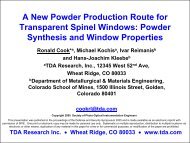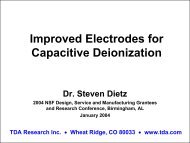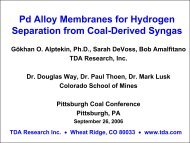Natural Gas Desulfurization for Fuel Cell Applications by Adsorption
Natural Gas Desulfurization for Fuel Cell Applications by Adsorption
Natural Gas Desulfurization for Fuel Cell Applications by Adsorption
Create successful ePaper yourself
Turn your PDF publications into a flip-book with our unique Google optimized e-Paper software.
Sulfur Poisoning• Sulfur compounds contaminate the catalysts used in fuel cellsystems and degrade power generation per<strong>for</strong>mance• Sulfur also poisons the catalysts used in the refomers, WGS reactorsand NOx trapsSource: De Wild, “The removal of sulfur-containingodorants from natural gas <strong>for</strong> PEMFC”, Proceedings of<strong>Fuel</strong> <strong>Cell</strong> Seminar, p227, 2002Source: Israelson, “ Results of Testing Various <strong>Natural</strong><strong>Gas</strong> <strong>Desulfurization</strong> Sorbents”, J. of MaterialsEngineering and Per<strong>for</strong>mance, Vol. 13 (3), June 2004• Traditionally sulfur removal is carried out with a two-step process:• HDS of the organic sulfur compounds and subsequent H 2S removal• It is not practical <strong>for</strong> small-scale residential units or <strong>for</strong> transportationsystems3 TDAR e s e a r c h
• Introduction• OutlineOutline• <strong>Natural</strong> <strong>Gas</strong> <strong>Desulfurization</strong>• Sorbent Per<strong>for</strong>mance• Effect of Moisture• Sorbent Regeneration• COS Removal• LPG <strong>Desulfurization</strong>• Sorbent Per<strong>for</strong>mance• <strong>Desulfurization</strong> of <strong>Natural</strong> <strong>Gas</strong> Liquids (NGLs)• Sorbent Per<strong>for</strong>mance• Effect of Aromatics• Field Demonstrations• Conclusions5 TDAR e s e a r c h
SulfaTrap TM Series Sorbents• High selectivity to all sulfur species• High capacity• Over 3% wt. breakthrough capacity (lb of sulfur per lb sorbent)• Over 5% wt. saturation capacity• High sulfur removal efficiency• Reduce sulfur levels to less than 5 ppbv• Regenerable operation• Demonstrated stable capacity <strong>for</strong> over 10 cycles• Oxidizing (e.g. air), reducing (e.g., H 2 or natural gas) or inert gases(e.g., N 2 ) can be used <strong>for</strong> regeneration• Low cost• Tolerance to natural gas contaminants• Moisture, heavy hydrocarbons, CO 2• Easy disposal• No flammability, toxicity or pyrophorocity6 TDAR e s e a r c h
HHHCHSDimethyl SulfideCHHCHHSTetrahydrothiopheneHHCHHCHSCCHHHHCHHCHHHCHTert-butyl Mercaptan<strong>Natural</strong> <strong>Gas</strong> <strong>Desulfurization</strong>Typical Organic Sulfur Compounds inNat. <strong>Gas</strong>HDMSTHTTBM• Among the organic sulfur species DMS wasfound to be the most difficult to remove• In the presence of mass transfer limitations(i.e. short gas-solid contact times) TBM andDMS breakthrough the same timeConcentration (ppmv)201816141210T= 20 o C, P= 2 psig, DMS = 12.3 ppmv, TBM= 9 ppmv, THT= 9 ppmv8642060,000 h -1 12,000 h -10 500 1000 1500 2000 2500 3000 3500 4000 4500 5000Time (min)DMSDMS THT THTTBMTHTTypical <strong>Natural</strong> <strong>Gas</strong> CompositionComponent Volume % Volume %Sample Jan. 2004 Sample June 2004Methane 92.83 92.39Ethane 3.30 3.42Propane 0.61 0.56Butane 0.13 0.11Isobutane 0.12 0.12Pentane 0.10 0.11Isopentane 0.10 0.10Neopentane 0.10 0.10Hexane 250 ppm 280 ppmCarbon Dioxide 0.70 0.81Nitrogen 2.01 2.087 TDAR e s e a r c h
Concentration (ppmv)109876543EMIPMPMMercaptan RemovalBreakthrough ProfileSulfaTrap-R350 ppmv H 2 O in natural gas, Total Sulfur Content= 81 ppmv, GHSV= 60,000 h -160,000 h-1 GHSVequal concentration of each odorantEthyl Mercaptan (EM)i-Propyl Mercaptan (IPM)Propyl Mercaptan (PM)2103% total capacity3% totalcapacity0 100 200 300 400 500 600 700 800Time (min)• SulfaTrap TM -R3 sorbent could remove mercaptans with high capacity(higher capacities are achieved <strong>for</strong> larger mercaptan species)• Earlier tests already showed its effectiveness <strong>for</strong> TBM9 TDAR e s e a r c h
Hydrocarbon <strong>Adsorption</strong>T= 20 o C, P= 17 psia, DMS = 17.0 ppmv, TBM= 7 ppmv, THT= 5 ppmv, GHSV= 60,000 h -11.04.0Relative IntensityFeed Analysis02.24.4GC Test Time (min)Breakthrough6.68.80DMSB-Merc240360120Test StartTest Time ...480Concentration, % vol.0.90.80.70.60.5600.40.30.20.10.0Ethane--->
20Effect of MoistureT= 20 o C, P= 5 psig, DMS = 46 ppmv in Nat. <strong>Gas</strong> GHSV= 60,000 h -1181646 ppm DMS 50 ppm H2O44 ppm DMS 350 ppm H2O44 ppm DMS 1046 ppm H2O60,000 h -1 GHSV1.74 % BT Loading1.64 % BT Loading1.27 % BT LoadingBreakthrough Concentration (ppmv)141210864200 50 100 150 200 250 300 350 400Run Time (min)• Most competing sorbents fail in the presence of high levels of moisture• Pipeline spec <strong>for</strong> moisture is 7 lb/MMSCF (corresponds to 154 ppmv H 2 O in the gas)• SulfaTrap TM -R3 sorbent maintains a stable sulfur capacity at high moisture levels,but capacity decreases if the water content goes above 1,000 ppmv11 TDAR e s e a r c h
SulfaTrap TM -R2• Fluctuations in moisture levelcould some times reach above2,000 ppmv H 2O.• <strong>Fuel</strong> cell manufacturers prefer asorbent which is more robustand does not have appreciablechanges in sulfur capacity withmositure levels• Hence the commercial sulfursorbent needs to be able tohandle any level of moisture inthe natural gas• We developed a moisturetolerant variation of our sorbent– SulfaTrap TM -R2DMS Concn. (ppmv)20161284T= 20 o C, P= 3 psig, DMS = 25 ppmv,EM = 25 ppmv, H 2 O = 4,000 ppmv inNat. <strong>Gas</strong> GHSV= 60,000 h -1DMSEM00 50 100 150 200Time (min)• SulfaTrap TM – R2 has high sulfurcapacity in the presence of veryhigh moisture levels12 TDAR e s e a r c h
Temperature Programmed DesorptionProfile <strong>for</strong> SulfaTrap TM -R2140400120THT350100Temperature300Concentration (ppm)806040DMSTMB250200150100Temperature (C)2050000 50 100 150 200 250Time (min)• If non-oxidizing gases are used, the sulfur species are simply released from thesorbent without any trans<strong>for</strong>mations• Sulfur balance between the adsorption and regeneration indicates full regeneration• The sorbent-DMS interaction is the weakest as evident <strong>by</strong> low desorptiontemperature• SulfaTrap TM -R2 is fully regenerated <strong>by</strong> heating to 300 o C in N 213 TDAR e s e a r c h
DMS Concentration (ppmv)21.81.61.41.210.80.60.40.2Regeneration Capability ofSulfaTrap TM -R2P= 3 psig, DMS = 7 ppmv, TBM= 7 ppmv, THT= 15 ppmv, GHSV= 75,000 h -1T <strong>Adsorption</strong>= 20 o C T Regeneration = 300 o CDMS Breakthrough Profiles in the 10-Cycle TestTotal Sulfur CapacityCycle 1, Hydrogen RegenerationCycle 2, <strong>Natural</strong> <strong>Gas</strong> RegenerationCycle 3, <strong>Natural</strong> <strong>Gas</strong> RegenerationCycle 4, <strong>Natural</strong> <strong>Gas</strong> RegenerationCycle 5, <strong>Natural</strong> <strong>Gas</strong> RegenerationCycle 6, <strong>Natural</strong> <strong>Gas</strong> RegenerationCycle 7, <strong>Natural</strong> <strong>Gas</strong> RegenerationCycle 8, <strong>Natural</strong> <strong>Gas</strong> RegenerationCycle 9, Hydrogen RegenerationCycle 10, Hydrogen Regeneration00 50 100 150 200 250 300 350 400 450 500Time (min)• SulfaTrap TM -R2 maintains its capacity <strong>for</strong> 10 adsorption/regeneration cycles• SulfaTrap TM -R2 regenerates using inert gases (such as nitrogen), hydrogenor natural gas <strong>by</strong> applying temperature swing• Although sulfur-free natural gas is preferred, sulfur-laden gas can also be usedprovided that it is at temperatureBreakthrough Capacity2.5%2.0%1.5%1.0%0.5%0.0%HydrogenRegeneration<strong>Natural</strong> <strong>Gas</strong>Regeneration0 2 4 6 8 10 12Cycle14 TDAR e s e a r c h
COS Removal• Sulfur compounds that are naturally present inthe natural gas are mostly H 2S or COS• Majority of this sulfur is removed at the well-heador at the distribution facilities, but a few ppm ofH 2S and COS still remains in the gas• COS is harder to remove than H 2S due to itsneutrality and similarity to CO 2.• Also H 2S reacts with CO 2present in the naturalgas to produce COS and water• All this makes it more difficult to remove COS atlow temperatures (in the range of ambient to200 o C)15 TDAR e s e a r c h
SulfaTrap TM -R5 <strong>for</strong> COS RemovalT= 22 o C, P= 1 psig, COS Inlet= 10 ppmv, H 2 O Inlet= 60 ppmv, CO 2 Inlet= 0.7% vol.,in natural gas, GHSV= 20,000 h -1 , Sample size= 10 cc4COS Breakthrough (ppmv)3.532.521.5Alco a S elexso rb @ 0.0 06% lo a d in gSulfaTrap TM -R3R3 @ 0.026 % loading0.03% wt. capacitySulfaTrap TM -R3(modified)0.20% wt. capacity645-21c @ 0.197% loading(in itial R5)20,000 h-1 GHSV10 p p m v C O S in let50 ppmv waterBalance <strong>Natural</strong> <strong>Gas</strong>1SulfaTrap TM -R50.74% wt. capacity685-37 @ 0.740% loading(curr ent R5)0.500 500 1000 1500 2000 2500 3000Run T ime (min)• SulfaTrap TM -R5 sorbent achieves acceptable COScapacity16 TDAR e s e a r c h
High COS removal Efficiency with R5MT= 22 o C, P= 1 psig, COS Inlet= 0.1 ppmv, H1202 O Inlet= 60 ppmv, CO 2 Inlet= 0.7% vol., innatural gas, GHSV= 20,000 h -1 , Sample size= 10 cc100SulfaTrap-R2ModifiedSulfaTrap-R5COS Concentration, ppbv80604020ProprietaryCarbon BModifiedSulfaTrap-R5B00 500 1000 1500 2000 2500Time, min.• We have further improved the SulfaTrap TM -R5M sorbent toachieve better COS removal efficiency• Modified SulfaTrap TM -R5M sorbent reduces the COScontent to less than 5 ppbv17 TDAR e s e a r c h
<strong>Desulfurization</strong> of LPG• Liquified petroleum gas(LPG) has higher powerdensity than natural gason volume basis• LPG-fed systems aresuitable fuel <strong>for</strong> portablesystems and applicationsin remote locations• Mercaptans (mostly ethyl,n-propyl and isopropylmercaptans) are theprimary sulfur species inLPGMethane MethaneEthane EthanePropane/PropyleneButylene ButyleneAAA PropaneIndustrialAAA PropaneGrade PropaneIndustrial Grade Propane0 60 120 180 240 300 360 420 4800 60 120 180GC Time, 240 sec300 360 420 480GC Time, secIso-Butane Iso-Butanen-Butane n-Butane• The presence of unsaturated hydrocarbons affects the per<strong>for</strong>mance ofthe desulfurization sorbents18 TDAR e s e a r c h
Sorbent Per<strong>for</strong>mance in LPGT=20°C, P=5 psig, GHSV= 5,000-30,000 h -1 , Ethyl Mercaptan Inlet = 13 ppmv–25 ppmvEthyl Disulfide (Relative Intensity)GHSV = 30,000 h -113 ppmv EMGHSV = 5,000 h -125 ppmv EMC 2 H 5 SH C 4 H 10 S 2Ethyl Mercaptan Diethyl disulfide0 2000 4000 6000 8000Time (min)• TDA’s SulfaTrap TM -R6 sorbent achieved sulfur capacity of 0.63% and2.35% wt. at GHSV of 30,000h -1 and 5,000h -1 , respectively (based ondiethyl disulfide breakthrough)19 TDAR e s e a r c h
SulfaTrap TM -R8 <strong>for</strong> Disulfide RemovalT=20°C, P=5 psig, GHSV= 30,000 h -1 , Inlet EM = 10 ppmv, EDS = 10 ppmvDisulfide Concentration (ppmv)109876543210Diethyl disulfide (EDS)Inlet 10 ppm EM, 10 ppm EDS0 1000 2000 3000 4000 5000 6000Time (min)• Disulfides when present in natural gas are more difficult to remove• Disulfides are also <strong>for</strong>med during desulfurization of some streams(e.g. LPG desulfurization)• TDA’s SulfaTrap TM -R8 sorbent achieved sulfur capacity of 2.50%(based on diethyl disulfide breakthrough)2.50% wtSulfur2.71% wtSulfur20 TDAR e s e a r c h
<strong>Desulfurization</strong> of <strong>Natural</strong> <strong>Gas</strong> Liquids• Conventionally caustic wash or solventtreatment is used to remove the sulfurspecies (mercaptans and DMS) fromNGLs, which is not selective to DMS• The amount of DMS present in the NGLscould sometimes be as high as 500-1000ppm• In order <strong>for</strong> the NGLs to be a viable <strong>by</strong>product,the sulfur present in the <strong>for</strong>m ofDMS needs to be removed to much lowerlevels.• <strong>Adsorption</strong> is a viable technique <strong>for</strong> DMSremoval from NGLs.Simulated NGL MixtureBP - NGL Mix% mol.Propane 32.73%Butane 29.11%Pentane 15.00%Hexane 7.50%Heptane 12.10%Toluene 3.50%Dimethyl Sulfide (DMS) + 0.0685%Propyl Mercaptan (PM) + 0.0048%3.5% aromatics+DMS – 664 ppmwPM – 57 ppmw• But the NGLs also contain aromatic species like benzene, toluene, ethylbenzene and xylenes (as high as 9% on molar basis)• Sorbent needs to retain its selectivity <strong>for</strong> organic sulfur species in thepresence of aromatics compounds.21 TDAR e s e a r c h
<strong>Desulfurization</strong> of <strong>Natural</strong> <strong>Gas</strong> LiquidsDMS concn. (ppmw)140120100806040T=40 o C, P= 150 psia, LHSV=4h -1BP - NGL Mix <strong>Desulfurization</strong>3.5% aromaticsUOP-13XSulfaTrap-R2A2000 20 40 60 80 100mL <strong>Fuel</strong> Desulfurized/g of Sorbent• SulfaTrap TM -R2A has more than twice the adsorption capacity of UOP-13X at 50 ppmw DMS breakthrough in the presence of aromatics• SulfaTrap TM -R2A sorbent can achieve ~1.5% wt. sulfur capacity vs.0.7% wt. of UOP-13X22 TDAR e s e a r c h
Effect of AromaticsT=40 o C, DMS Conc.= 75 ppmw S, NPM=1,020 ppmw S, P= 2 psig, LHSV=4h -11.21.2Normalized Hydrocarbon peakArea from GC-MS10.80.60.40.20UOP-13XBenzeneTolueneEthyl BenzeneXylene0 5 10 15 20 25Total Sulfur Concn. (ppmw S)10.80.60.40.20SulfaTrap-R2ABenzeneTolueneEthyl BenzeneXylene0 5 10 15 20mL <strong>Fuel</strong> Desulfurized/g sorbentUOP-13X SorbentmL <strong>Fuel</strong> Desulfurized/g sorbentTDA SulfaTrap TM -R2A Sorbent• The adsorption of aromatichydrocarbons was evident with theUOP-13X sorbent• competitive adsorption between aromaticsand sulfur• No hydrocarbon adsorptionwas observed with theSulfaTrap TM -R2A• Highly selective sulfuradsorption23 TDAR e s e a r c h
Field Demonstrations – <strong>Natural</strong> gasDemonstration PartnersSiemensDelphi<strong>Fuel</strong><strong>Cell</strong> Energy<strong>Fuel</strong> <strong>Cell</strong> TechnologyLogan EnergyGTTGaz de France• 5kW e desulfurizer atSiemens’s R&D center inPittsburgh, PA• 2.2 L sorbent bed (oversized)provided 1 year continuousoperation• 5 kW e desulfurizer at FCTC inJohnstown, PA (then deliveredto Fort Meade Army base, MD)• 2.0 L sorbent• No voltage drop over 12,200 hrtesting24 TDAR e s e a r c h
Large Scale Demonstrations• Several demonstrations were carried out with Siemens at large scale (100and 125 kW eCHP SOFC systems)• Two large-scale demonstrations were carried out in Europe in Italy andGermany• European gas contains high concentrations of COSTDA’s 100 kWeDesulfurizer atGTT, Milano, Italy• In 2007, TDA produced and delivered 1,500 lb of SulfaTrap TM -R seriessorbents in-house• In 2008, we already had a 780 lb order; this is expected to grow up to20,000 lb25 TDAR e s e a r c h
Field Demonstrations – LPG• 18 cc sorbent cantreat a 20 lbcommercial LPGtank• 0.5 cc sorbenttreat 2 lbColeman tankSulfaTrap TM -P -R6SorbentLPG <strong>Fuel</strong> Tanks75 W MesoGenSOFC BatteryCharger• Field testing with Mesoscopic Devices• 75-100 W eportable SOFC as field batterychargers• 20 cc sorbent provided 10 daycontinuous operation• Other partners:• <strong>Fuel</strong><strong>Cell</strong> Energy• Adaptive Materials• Protogenics26 TDAR e s e a r c h
Conclusions• TDA’s sorbent SulfaTrap TM -R3 can be effectively andeconomically used <strong>for</strong> natural gas desulfurization• TDA’s SulfaTrapTM-R2 sorbent works under any levels ofmoisture <strong>for</strong> desulfurization of natural gas• TDA’s SulfaTrap TM -R5 sorbent has very good COS removalcapacity• TDA’s SulfaTrap TM -R6 sorbent can achieve 2.35% wt. capacity<strong>for</strong> desulfurization of LPG• TDA’s SulfaTrapTM-R8 sorbent can remove disulfides with acapacity greater than 2.5% wt.• TDA’s SulfaTrapTM-R2A sorbent has 1.5% sulfur capacity <strong>for</strong>desulfurization of NGLs• SulfaTrap TM Series sorbents could be used either individuallyor in combinations depending on the gas composition27 TDAR e s e a r c h


